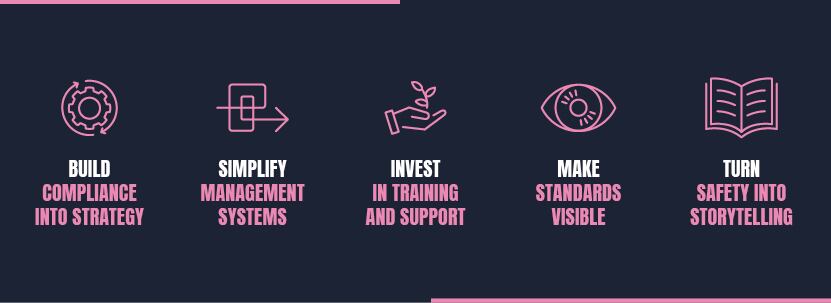Every restaurant owner knows that hospitality today is about far more than food and service. Rising costs, staffing shortages and economic pressures are only part of the challenge. Add instant online visibility of customer experiences, the speed with which social media can build or break reputation, growing focus on allergens and food safety, and the fact that customers are placing increasing importance on assurance schemes like the Food Hygiene Rating Scheme and Safe to Trade.
Research makes it clear: consumers want confidence, not guesswork: 78% actively look for food hygiene ratings before eating out or ordering a takeaway. The result? A landscape where compliance and customer trust are inseparable, making transparency and accountability a key differentiator and where getting it right is more critical than ever.
The Risks of Getting It Wrong
- Unlimited fines for breaches.
- Poor hygiene ratings that stop bookings before they start.
- Training and system costs that stretch already thin resources.
- Investment decisions that weigh heavily on already tight margins.
And these consequences are both financial and reputational, which is why many restaurant businesses are rethinking how they manage compliance and the conversation is moving away from a regulatory hurdle towards recognising strategic value.
This shift changes the internal discussion. The central question is no longer “How do I avoid fines?” or “How can I tick this box in the most cost-effective way?” but towards “How can I use safety and compliance to build stronger customer relationships, protect my brand, and gain an edge in a competitive market?”
Why Safety Matters
Hospitality is built on trust. Guests want reassurance that their wellbeing is a priority, and safety standards directly shape where they choose to eat.
The customer journey shows it clearly:
- Guests check your online presence before visiting.
- First impressions are formed by cleanliness.
- Allergy sufferers, pregnant individuals, and vulnerable groups seek clear reassurance.[AS1]
- Consumers feel most confident when inspections are recent, Safe to Trade’s ongoing verification provides real-time reassurance, something a static sticker cannot.
- Recommendations can, in part, be swayed by whether the experience felt safe and professiona[AS2] l.
These steps that the customer goes through help to build reassurance and confidence which in turn drives loyalty and spend. Put simply, customers who feel secure stay longer, spend more, return more often, and share positive experiences. Help support business growth.

From Cost to Competitive Advantage
Compliance used to be seen as box-ticking. Forward-thinking operators are recognising that safety is part of their value proposition and when done well can become a source of competitive advantage.
Customers see the difference between venues that do the bare minimum v ones that visibly prioritise their wellbeing – and in an age where reviews, ratings, and social media can amplify perceptions instantly, that difference matters.
Done well, investment in safety systems and processes has positive business outcomes:
- Lower risk of fines and reputational damage.
- Smoother operations and simplified systems.
- Building a stronger brand.[AS3]
- Greater customer trust, spend, and repeat visits.
- More confident, empowered teams.
It’s about aligning with what customers care about, safety and trust, and turning those expectations into a clear point of difference.
Practical Steps for Restaurant Owners
Restaurant owners looking to make this shift often ask: Where do I begin? There are several key areas to consider.
- Make compliance strategic – align it with growth, experience, and reputation.
- Simplify systems – reduce errors with centralised tools.
- Invest in training and support – empower staff with clarity and confidence.
- Show standards visibly – FHRS and Safe to Trade should be part of the guest journey.
- Tell your safety story – transparency builds trust and advocacy.

The Customer Experience Advantage
When these principles are applied, compliance evolves from a silent safeguard to an active contributor to customer experience. Guests feel relaxed, staff deliver more confidently, and safety becomes a reason customers choose your venue. The link is clear: safety builds confidence, confidence builds loyalty, and loyalty fuels growth.
The Risk of Standing Still
Consumers are more likely to trust businesses that actively display food safety and hygiene i[AS4] nformation, without it trust and bookings can evaporate. The financial consequences are often far greater than the direct costs of improving compliance in the first place.
A New Mindset for Growth
The strongest operators will treat compliance not as an obligation, but as a growth strategy, driving trust, loyalty, and sustainable success. By putting safety at the heart of customer experience, businesses protect themselves and create the conditions for long-term growth.
At Shield Safety, we help businesses make this shift. Our Shield Safety Suite of Cover supports operators to move beyond compliance into creating safer, stronger, and more trusted customer experiences. Helping turn regulatory requirements into a competitive business advantage.
[AS1]low risk appetites is wrong - its more vulnerable groups
[AS2]its not the only thing
[AS3]not brand positoning thats something different - building a stronger brand
[AS4]food safety and hygiene (as this woudl wrap in STT)


